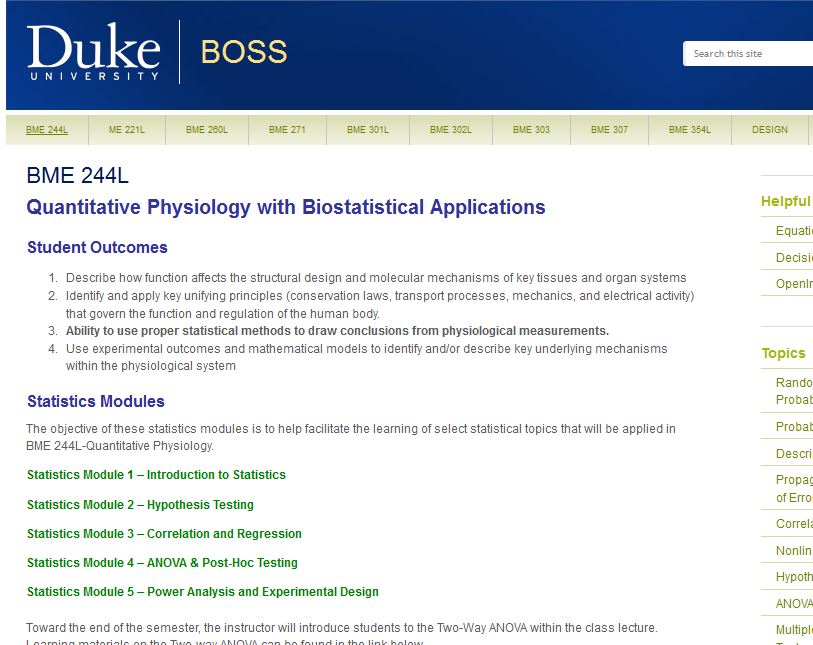Faculty in Duke’s Biomedical Engineering Department agreed that students needed to apply statistics to biomedical engineering problems throughout the curriculum. Rather than teach a separate statistics course, they decided to formally incorporate statistics into the biomedical engineering (BME) curriculum; a faculty committee identified the relevant statistics topics and mapped them to the BME courses.

I = introduction, T = taught in some depth, U = uses topic
To support students learning statistics throughout the curriculum,  Steve Wallace developed a BME online statistics source (BOSS). The BOSS would provide continuity and uniformity of statistics education for BME majors while assisting faculty to integrate statistics in their courses.
Steve Wallace developed a BME online statistics source (BOSS). The BOSS would provide continuity and uniformity of statistics education for BME majors while assisting faculty to integrate statistics in their courses.
Dr. Wallace listed requirements for the BOSS:
- provide background material to learn statistical concepts
- provide review materials for these concepts
- demonstrate biomedical applications of statistics
- provide interactive evaluation for practice
- user friendly experience
- accessible with mobile devices
- use existing material as much as possible to save time.
Development of the BME online statistics source
Dr. Wallace put together a team of students in a course (BME 590: Statistics in BME) to produce the first BOSS in Sakai, reasoning that students themselves would best be able to identify materials that students would find useful.
Dr. Wallace piloted and evaluated the first BOSS in a course he was co-teaching. Students rated their level of agreement with the statement: “This course improved my ability to apply statistics to solve engineering problems or problems at the interface of engineering and biology”. Average student agreement (1 to 5):
Prior to BOSS implementation: 3.29.
During BOSS implementation: 4.47.
To implement upgrades, Dr. Wallace worked with another team of students (BME 590, Implementation of BOSS) to re-launch the BOSS on WordPress. He continues to improve the BOSS, advises other BME faculty on integrating statistics supported by BOSS in their courses, creates course-specific BOSS pages, and is gathering data to inform the next BOSS redesign.
BME Online Statistics Source design
Dr. Wallace thought carefully both about the design of the BOSS itself, and the process for designing the BOSS. He:
- collaborated with students to address their specific needs
- implemented continuous improvement in response to user needs
- gathered data on student use to improve the design and add resources
- solicited faculty input from both BME faculty and statistics faculty
- considered longevity and ease of maintenance of the site
In the BOSS, each topic begins with explicit Learning Objectives, key terms and their definitions, and then a series of links to resources which address the topic in text, graphics, models, and video. Students can choose the resources that best help them. Topics are organized by title, and also mapped to the relevant BME courses so that students can access what they need quickly. There are example problems with detailed solutions, equation lists, MATLAB tutorials and built-in quizzes for self-testing.
Visit BOSS and try it out yourself (log in with your Duke netid)
Student reaction
One student commented:
The integration of statistics in this class is great. I find it essential for me to fully understand and be engaged in the labs in my other classes as well. Some examples:
-In EGR 201L Mechanics of solids, my knowledge of linear regression allows me to compare the Young’s Modulus that I found in my experimental stress-strain curve with that of literature values, not only with percentage error, but also with confidence intervals!
Statistics made labs fun for me, before this semester, when in lab, I just followed the instruction in the handout without thinking. Now after the stats modules, I find myself constantly thinking about the implication of each action on experimental error and what to look out for in the experiment. In my personal opinion, any student in Pratt who does not get exposed to the application of statistics in engineering AS EARLY AS POSSIBLE will not be able to appreciate the labs in their classes nearly as much.
Integrating stats within a course that demands its application makes stats quick and easy to learn.

